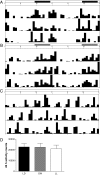Light at night increases body mass by shifting the time of food intake
- PMID: 20937863
- PMCID: PMC2972983
- DOI: 10.1073/pnas.1008734107
Light at night increases body mass by shifting the time of food intake
Abstract
The global increase in the prevalence of obesity and metabolic disorders coincides with the increase of exposure to light at night (LAN) and shift work. Circadian regulation of energy homeostasis is controlled by an endogenous biological clock that is synchronized by light information. To promote optimal adaptive functioning, the circadian clock prepares individuals for predictable events such as food availability and sleep, and disruption of clock function causes circadian and metabolic disturbances. To determine whether a causal relationship exists between nighttime light exposure and obesity, we examined the effects of LAN on body mass in male mice. Mice housed in either bright (LL) or dim (DM) LAN have significantly increased body mass and reduced glucose tolerance compared with mice in a standard (LD) light/dark cycle, despite equivalent levels of caloric intake and total daily activity output. Furthermore, the timing of food consumption by DM and LL mice differs from that in LD mice. Nocturnal rodents typically eat substantially more food at night; however, DM mice consume 55.5% of their food during the light phase, as compared with 36.5% in LD mice. Restricting food consumption to the active phase in DM mice prevents body mass gain. These results suggest that low levels of light at night disrupt the timing of food intake and other metabolic signals, leading to excess weight gain. These data are relevant to the coincidence between increasing use of light at night and obesity in humans.
Conflict of interest statement
The authors declare no conflict of interest.
Figures




References
-
- Hill JO, Wyatt HR, Reed GW, Peters JC. Obesity and the environment: Where do we go from here? Science. 2003;299:853–855. - PubMed
-
- Golombek DA, Rosenstein RE. Physiology of circadian entrainment. Physiol Rev. 2010;90:1063–1102. - PubMed
-
- Kohyama J. A newly proposed disease condition produced by light exposure during night: Asynchronization. Brain Dev. 2009;31:255–273. - PubMed
-
- van Amelsvoort LG, Schouten EG, Kok FJ. Duration of shiftwork related to body mass index and waist to hip ratio. Int J Obes Relat Metab Disord. 1999;23:973–978. - PubMed
Publication types
MeSH terms
LinkOut - more resources
Full Text Sources
Other Literature Sources
Medical
Research Materials

